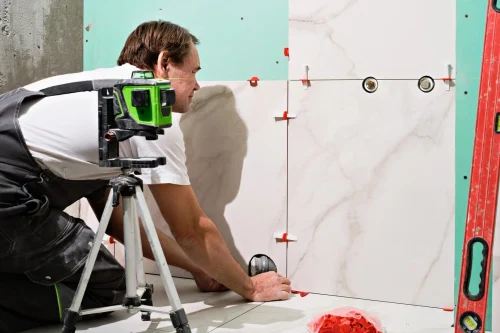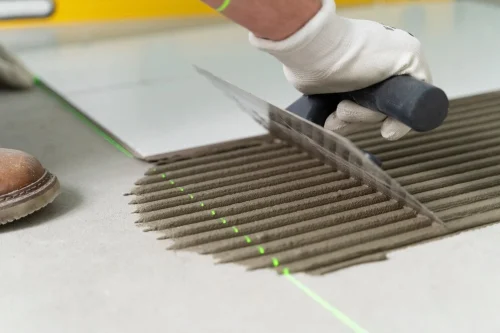
Reshape Your House using uPVC Sliding Door with Grill for Maximum Security with Minimal Effort
April 22, 2025
Water Tank On House: Choosing The Best Water Storage For Your Home
April 23, 2025Table of contents
Tiles do more than enhance the appearance of interiors. They protect, support, and make a lasting impact on members and visitors.
But here's the catch: Choosing tiles based on their appearance can lead to damage, such as cracks, water absorption, slips, and more.
Whether you are a homeowner, architect, or contractor, tile quality testing is essential when designing your interiors.
This blog breaks down the essential tile tests that ensure you pick the right tiles for your home. Tiles are not only made to impress but also to perform well.
What is Tile testing?
Tile testing is a process of examining the quality, durability, and safety of tiles before installing them. It ensures that they meet industry standards for their required use in residential, commercial, or industrial interior spaces.
During testing, tiles are tested for water absorption, strength and resistance to cracks, chemical usage, and slip resistance. This is essential to determine their ability to withstand foot traffic, handle moisture exposure and chemicals, and withstand temperature changes.
It is also checked for protecting against future issues like cracking or popping. Tile testing protects your investment by guaranteeing the tiles are functional and long-lasting.
Why is Tiles Testing Important?
Tiles are exposed to multiple stresses, more than you think. From foot traffic to environmental conditions, poor-quality tiles will soon result in problems like cracking, water damage, and safety hazards. This will again lead to slippery floors, cracked surfaces and go for expensive repairs.
Utilizing the appropriate testing methodologies helps in the following:
Durability: Ensures the tiles can handle daily wear and tear at home..
Safety: Reduces the risk of slips, cracks, and accidents at home.
Compliance: Meets industry standards of building and selling..
Cost Efficiency: Saves you from repeated replacements or costly repairs.
Global Market Insights' report states that ceramic tile sales exceeded USD 91 billion in 2022 and continue to expand exponentially - making quality tile control all the more crucial.
Read more - Find the Right Waterproofing Chemical for Terrace
Essential Tiles Quality Tests
Here are some of the essential tile quality tiles tests that you can consider:
1. Water Absorption Test
This tile test measures the porosity and suitability of the tiles for different environments. The process involves a 24-hour submersion in water. First, it weighs the dry tile, then submerges it in water for 24 hours and weighs it again at the end.
Water absorption percentages can be calculated using this formula: (Wet Weight—Dry Weight)/ Dry Weight x 100%. To meet the proper industry specifications, porcelain tiles should have an absorption rate of 0.5%.
Implication: Tiles with low water absorption rates are ideal for wet environments such as bathrooms, kitchens, and outdoor spaces.
Tiles with higher porosities could lead to mould growth, cracking, or liquid leakage through their pores, which could result in mould growth or water entering their structure.
2. Breaking Strength Test
This test determines the tile's ability to prevent slips. Standard equipment, such as tribometers, measures its coefficient of Friction (COF).
COF (Coefficient of Friction) measures the resistance when an object slides over tile surfaces. A COF value greater than 0.42 is recommended for wet areas.
Applications: This is crucial for bathrooms, poolsides, kitchens, and other environments where frequent exposure to moisture occurs.
3. Chemical Resistance Test
This tiles test assesses a tile's ability to resist staining and degradation caused by chemicals. To do this, tile samples are exposed to household or industrial detergents, acids, or oils for several hours at various temperatures before being evaluated for resistance.
Be vigilant of changes in appearance, colour, or surface texture over time. ASTM C650 provides procedures for chemical resistance testing, which must be undertaken when purchasing tiles used in kitchens, laboratories, or commercial kitchens.
4. Dimensional Stability
The purpose of this test is to ensure tiles maintain shape and size when exposed to temperature variations.
The method includes measuring tile dimensions before and after exposure. The deviations are calculated and compared against the standard limits.
The standards are ISO 10545-2 provides guidelines for testing dimensional stability. Testing helps prevent uneven flooring, misalignment, and tile popping after installation.
Read more - Types of Beds for Bedroom
5. Other Checks
While major tiles tests ensure its compliance with industry standards, several simple field tiles tests can also offer valuable insights:
Visual Inspection: Inspect for cracks, warping, or discoloration.
Tap Test: Gently tap tiles; any hollow sound indicates interior cracks.
Flatness Check: Before installing tiles, perform a flatness check to ensure they're not bowing or bent. These small steps can save time and reduce installation issues later.
Read more - Guide to Pipes and
Conclusion:
While tiles may seem like a simple decor choice, their quality impacts safety, longevity, and overall satisfaction. Having tiles tested early could save costly repairs for the safety risks in the future.
Whether you are choosing tiles for your kitchen or building materials for an apartment complex, these tests can ensure that every tile meets your expectations and requirements .
Remember: A stunning-looking tile won't help you if it doesn't perform well.
Discover GreenFortune - Your Trusted Partner for Top-quality uPVC Windows and Doors
GreenFortune is your go-to solution for providing energy-efficient windows and doors with visual appeal, long-term performance, and premium comfort for your home improvement plans.
Green Fortune windows and doors, made with premium UPVC solutions specifically for each application, will add visual appeal and provide long-term performance.
Choose GreenFortune now and experience our extraordinary quality, design, and customer service.
FAQs
How often should tiles quality be tested during big projects?
At least three times - before purchase, mid-delivery (batch check), and post-installation to ensure consistency and avoid tiles quality issues later.
Can tile testing be done on-site?
Basic checks like tap tests and flatness can be done on-site. However, strength, abrasion, and chemical tests require a certified lab for accuracy.
What are early signs of poor tile quality?
Hairline cracks, stains that don’t clean, tile popping, or slippery surfaces over time suggest low-quality tile or wrongly installed tiles.








